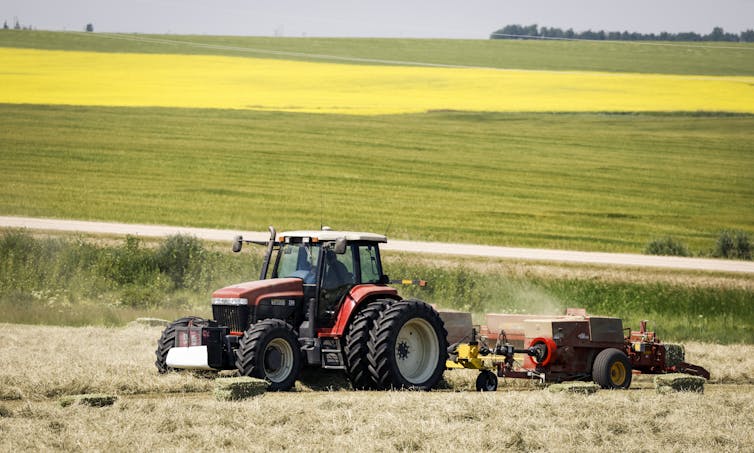The federal government’s plan to cut fertilizer emissions by 30 per cent by 2030 has garnered significant attention from farmers, agriculture organizations and other industry stakeholders.
Some have argued that the emissions reduction target will threaten food production and lead to shortages, while others have compared it to the proposed emission cuts in the Netherlands that have driven Dutch farmers to protest.
While similar protests could potentially erupt in Canada, it is important to understand the differences between the proposals in Canada and the Netherlands.
Our assessment is that the fears of catastrophic yield reductions and food shortages are exaggerated.
Netherlands vs. Canadian targets
The targets in the Netherlands call for the significant reduction of excess nitrogen, from both crop and livestock production, in order to reduce greenhouse gas emissions and nutrient loadings into water.
The reduction in nitrogen is to largely happen through a significant reduction in livestock numbers. The Dutch government has allocated 25 billion euros to buy out over 11,000 livestock farms, while over 17,000 farmers will have to reduce their livestock.
The substantial reductions will be disruptive for many farmers, especially those in the areas with higher reduction targets. These targets will undoubtedly reduce the amount of Dutch livestock products.

(AP Photo/Peter Dejong)
The Canadian reduction target differs from the Dutch target because it focuses on fertilizer-related emissions in the form of nitrous oxide (an important greenhouse gas), rather than curtailing the use of fertilizers itself.
The distinction between fertilizer greenhouse gas emissions and overall fertilizer use is important because there are ways of reducing emissions that do not necessarily require a reduction in fertilizer, and definitely don’t require a reduction in yields.
The Canadian government has also assured farmers that they will not be taking a hard target regulatory approach to meet the reduction objective.
The 4Rs framework
A useful framework for thinking about fertilizer is the 4Rs of nutrient stewardship: using the right fertilizer source, at the right rate, at the right time and at the right place.
This framework was developed by the fertilizer industry for two reasons. First, it allows farmers to increase the efficiency of fertilizer application by more effectively using applied nutrients.
The United States Department of Agriculture estimates that farmers can save $30 per acre by implementing nutrient management plans and incentivizes those who implement them through the Inflation Reduction Act. Second, it is more environmentally sustainable because it reduces the amount of emissions from fertilizer application.
By applying the 4Rs framework and increasing fertilizer efficiency, farmers will be able to achieve the emissions reduction target without suffering significant losses in production. Fertilizer Canada estimated that increased efficiency through specific 4R practices could reduce emissions by up to 35 per cent.
Agriculture and Agri-Food Canada predict similar emissions reductions. These practices include using enhanced efficiency fertilizers and adjusting the timing of fertilizer application.
The reduction targets are also intended to drive fertilizer innovation in all four areas of the 4Rs framework. Establishing targets is a good way to prioritize areas for research and practice innovation in agriculture. We have the capacity to achieve these emissions reductions.
Change is daunting, but necessary
The Canadian policy approach to achieve reductions in nitrous oxide emissions from crop production is to encourage the use of 4R practices, not specify a cut in fertilizer use. Education efforts are in place to reduce excess nitrogen use.
In addition, the Canadian goverment’s On-Farm Climate Action Fund has provided industry groups with funds to work with farmers to increase the adoption of 4R practices that improve fertilizer management. These cost-share programs are voluntary.
The current economic situation will also make it in the best interest of farmers to improve the efficiency of fertilizer use. High oil prices and the conflict in Ukraine are among factors that are contributing to high fertilizer prices. Production of ammonia (an important source of nitrogen fertilizer) is being curtailed in Europe, as Russia cuts shipments of natural gas.

THE CANADIAN PRESS/Jeff McIntosh
Nitrogen fertilizers will continue to be expensive and in short supply for some time. Making the most efficient use of what is currently available will make economic sense to farmers, while still contributing to reducing emissions.
The emission reduction targets outlined for Canadian fertilizer use will not lead to food shortages and food insecurity. Canadians generally — and farmers specifically — will have to change to address the challenges brought on by climate change.
Read more:
How Canadian agricultural producers can lead the way in climate action
In many cases, we have the ability to positively reduce emissions without disrupting agricultural production. There are farmers today that are doing just that by optimizing fertilizer usage.
In today’s climate, it makes economic sense to adopt some of these practices to reduce emissions. Change can be daunting, but it is critical that we have a reasoned discussion about what we can do now and in the future. The current polarized debate is not productive.